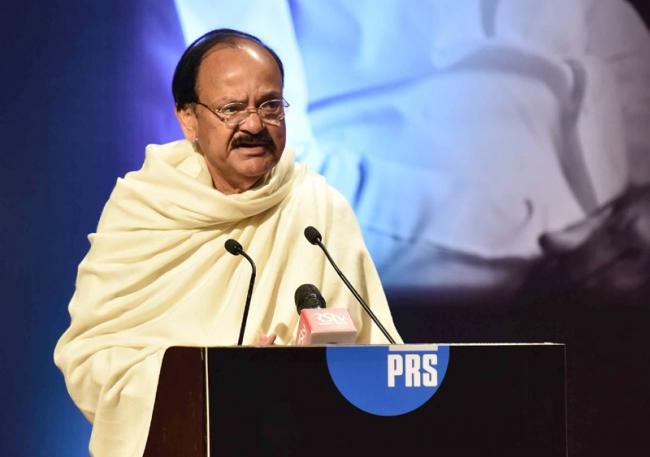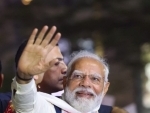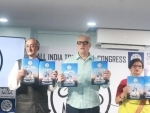
Industry should increase investments in Agriculture sector: Vice President Naidu
New Delhi, Feb 24 (IBNS): Vice President of India M. Venkaiah Naidu has said that industry should increase investments in agriculture as over 58 per cent of the rural households are dependent on agriculture in India.
He was addressing the CII Partnership Summit 2018, in Vishakhapattanam, Andhra Pradesh on Saturday.
The Chief Minister of Andhra Pradesh, N. Chandrababu Naidu, the Union Minister for Commerce & Industry, Suresh Prabhakar Prabhu, the Union Minister for Civil Aviation, Ashok Gajapathi Raju Pusapati and other dignitaries were present on the occasion.
The Vice President said asked investors to look into the tremendous potential for investments.
He further said that value addition can be made in agriculture and allied sectors like dairying, fisheries, poultry, food processing, setting up of cold storage facilities and refrigerated vans.
Adding value to the farm produce is crucial for increasing farmers income and establishing agri-related industries in the rural areas will not only provide employment but also help in minimizing migration to cities, he added.
The Vice President said that Vital structural reforms like the implementation of demonetization and GST by the Indian government have led to an expansion of the formal economy and brought about increased tax compliance. The number of people, who had filed Income Tax returns increased from 6.47 crore in 2014-15 to 8.27 crore at the end of 2016-17, he added.
The Vice President said that Indian companies need to identify segments of global value chains with higher value addition and low entry barriers in global markets to achieve higher exports in the short term.
He further said that connecting to global value chains is critical for Indian MSMEs. Access to technology and internet can be a major factor to allow SMEs to integrate with the global market and e-trade allows SMES to reach out to new export avenues and access to low-cost imported inputs, he added.
The Vice President welcomed the delegates to the Sunrise State of Andhra Pradesh, which is among the top States in the Ease of Doing Business.
He further said that this State is endowed with a rich vast mineral resources, long coastline, talented human resources and most importantly uninterrupted power supply. It is endowed with rich natural resources & mineral wealth and boasts of the second longest coastline of 974 kms in the country next to Gujarat and it has 1000km of National Highways, 3 International airports and 5 operational airports, he added.
Following is the text of Vice President's address:
"We have gathered here at a time when India has emerged as one of the growing large economies in the world and the global outlook also looks brighter.
As per the IMF World Economic Outlook of January 2018, the Indian economy is projected to grow at 7.2 per cent in 2017 and 7.7% in 2018.
India is expected to become the third largest economy in the next 10-15 years and grow from $2.3 trillion today to about $8 trillion, with an average income of over $5,000.
As you all are aware, the world economy has undergone tremendous structural shifts due to rising influence and role of the emerging economies across the globe. This has led to a shift of balance of powers between the global north and the global south. This is perhaps the most significant geo-political development of the recent times.
The emerging economies including countries like India, China and Brazil have evolved from being policy takers to policy makers and are playing a significant role in multilateral world bodies.
Vital structural reforms like the implementation of demonetization and GST by the Indian government have led to an expansion of the formal economy and brought about increased tax compliance. The number of people, who had filed Income Tax returns increased from 6.47 crore in 2014-15 to 8.27 crore at the end of 2016-17.
Any tough reform will face teething problems in the initial stages and the same was the case with both demonetization and GST. However, the long-term advantages will definitely outweigh the short-term hiccups which caused a bit of economic slowdown. Well, that period is over now and the economy is on the track to achieve a higher growth.
As a result of strong macro-economic fundamentals and reforms, the Indian economy has been improving steadily. For instance, the Current Account Deficit (CAD), which ranged between 6.8 per cent and 4.2 per cent in the past, is now in the range of 0.5 per cent to 1.5 per cent. Similarly, the Fiscal Deficit hovered between 5.9 per cent and 4.5 per cent earlier. Now, it has been brought down to 3.5 per cent. It could have been reduced to 3.2 per cent, but for shortfall of GST revenue by a month.
The major reforms include harmonization of indirect taxes through GST, easing the regulatory environment, facilitating foreign direct investment across all sectors, massive recapitalization of the public sector banks at Rs.2.11 lakh crore to improve credit growth and investment and the implementation of Insolvency and Bankruptcy Code, 2016.
Various reformatory measures have improved India’s ranking in the World Bank’s Ease of Doing Business by 30 slots—from 130 to 100. Friends, today India has emerged as a bright spot in the global economy and investors from around the world are coming here because of a host of advantages the country offers.
The FDI inflows have increased steadily from US$ 45 billion in 2014-15 to touch US$ 60 billion in 2016-17. India’s exports have been recovering steadily over the last several months and grew at over 12 per cent in the first three quarters of 2017-18.
A key item on the reform agenda has been restructuring of the banking system to reduce the non-performing assets. The recently introduced Insolvency and Bankruptcy Code is being used by the RBI to speed up recoveries. Privatization as also sale of public sector units is being undertaken in many areas where the enterprises have been consistently making losses.
Apart from implementing reforms, the governments both at the national level and in various States are implementing measures to ensure a conducive atmosphere for businesses to grow. However, every reform should have a human face. There should be equitable distribution of prosperity and the fruits of development must reach the poorest of the poor.
Another area that is receiving top attention is infrastructure growth. Airports, ports, railways, power plants, roads, bridges and hotels, among others, are in an expansion mode. It is estimated that an investment of Rs 43 trillion is required over the next five years in sectors such as power, roads, ports and urban transportation.
India is a young nation with about 60 per cent of the population under the age of 35 years. Various initiatives like Skill India, Start-up India and Digital India have been launched to convert this huge, educated human resource talent into a “demographic dividend”.
India has become the third largest start up eco-system in the world. According to a NASSCOM report, about 1,000 start-ups were added in 2017 taking their number to nearly 5,200. Interestingly a chunk of these start-ups are from Tier-II and Tier-III cities.
With growing middle class, rising disposable incomes, expanding consumer market and the presence of a young, talented work force, the MNCs and other global giants are apparently looking to India. There is also a healthy competition among various State Governments, which are implementing reforms to attract investors.
Friends, another important area that needs the attention of both the government and investors is agriculture. Over 58 per cent of the rural households are dependent on agriculture in India, which is endowed with a vast agro-ecological diversity. There is tremendous potential for investments and value addition in agriculture and allied sectors like dairying, fisheries, poultry, food processing, setting up of cold storage facilities and refrigerated vans. As you all are aware, adding value to the farm produce is crucial for increasing farmers’ income. In view of the important role played by the food processing sector, the government has doubled the allocation to Rs.1,400 crore in this year’s budget. Establishing agri-related industries in the rural areas will not only provide employment but also help in minimizing migration to cities.
On the external front, the global economy is showing signs of pick-up after a prolonged phase of economic slowdown. According to recent OECD report, global GDP is projected to show a modest rise to 3.5 % in 2017 and 3.7% in 2018 from 3.2% in 2016. Yet the projected rates for global growth are much below pre-crisis averages, especially for the advanced economies as well as commodity exporting countries. This could bring attendant repercussions which might undermine the nascent signs of growth revival.
Already there are calls for protectionism from the advanced economies which, when implemented, could mean restrictive policies for cross-border trade and investment flows.
Although, India has a lot of trading agreements, both regional and bilateral, the country is yet to fully capitalize on the existing synergies in its Regional Trading Agreements. An example is the South Asian Free Trade Agreement (SAFTA) as South Asian region is the least integrated among all the regions in the world. The regional value chain (RVC) approach could be an appropriate model to foster intra-regional trade by deepening regional processes.
I feel the Indian companies need to identify segments of global value chains with higher value addition and low entry barriers in global markets to achieve higher exports in the short term.
In addition, connecting to global value chains (GVCs) is critical for Indian MSMEs. Access to technology and internet can be a major factor to allow SMEs to integrate with the global market. E-trade allows SMES to reach out to new export avenues and access to low-cost imported inputs.
Finally, I would like to welcome all of you to the Sunrise State of Andhra Pradesh, which is among the top States in the Ease of Doing Business. This State is endowed with a rich vast mineral resources, long coastline, talented human resources and most importantly uninterrupted power supply. Opportunities are aplenty for investors in different sectors, including pharmaceuticals, textiles, food processing, automobiles and electronics among others.
Andhra Pradesh, India’s Sunrise State, is a gateway to growing markets and promising opportunities with many advantages. One among the top states in the Ease of Doing Business.
It is endowed with rich natural resources & mineral wealth and boasts of the second longest coastline of 974 kms in the country next to Gujarat. It has 1000km of National Highways, 3 International airports and 5 operational airports. It has first river linking project. It has two industrial corridors. Its fast becoming a Pharam & Auto hub. It’s becoming a Solar power house with 1000MW installed and 1000 MW coming up.
India poised to be a $10tn eco by 2030, which is four times bigger than its current size, by 2030.
To achieve this country may have to adopt several unorthodox measures. For instance, with around 120 million people set to join the Indian workforce, skilling them in a short span of time is essential, “You cannot do that with conventional education, time frames of educating or imparting skill to people should be shortened” said Barton.
My best wishes for the success of all your endeavors to partner in India’s growth story. Thank you.
JAI HIND!"
Support Our Journalism
We cannot do without you.. your contribution supports unbiased journalism
IBNS is not driven by any ism- not wokeism, not racism, not skewed secularism, not hyper right-wing or left liberal ideals, nor by any hardline religious beliefs or hyper nationalism. We want to serve you good old objective news, as they are. We do not judge or preach. We let people decide for themselves. We only try to present factual and well-sourced news.







